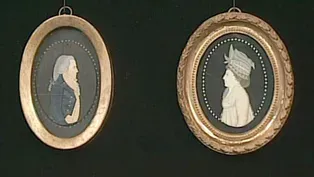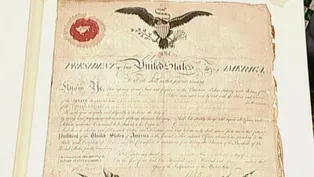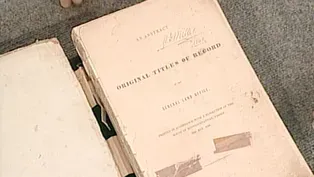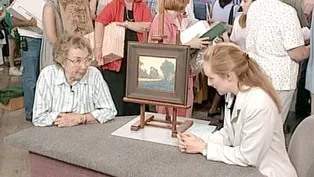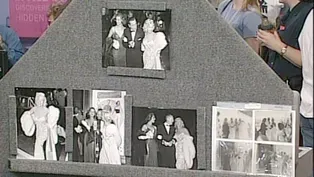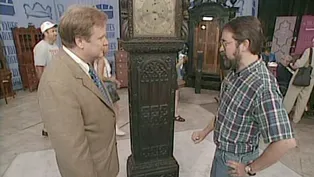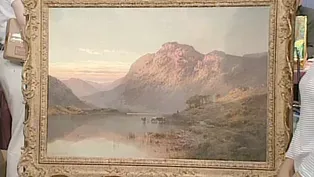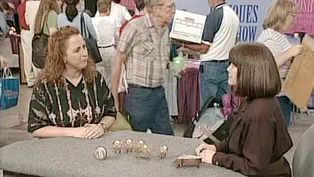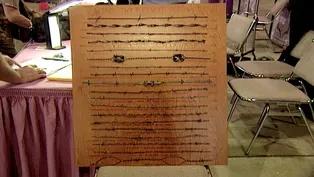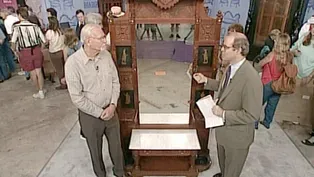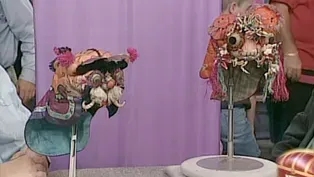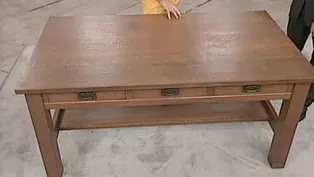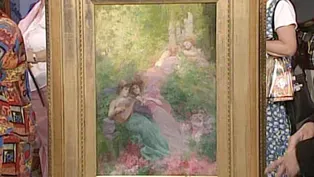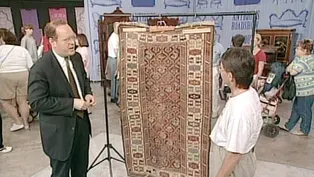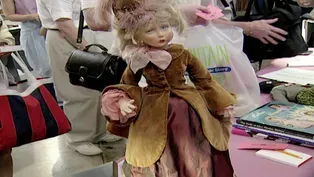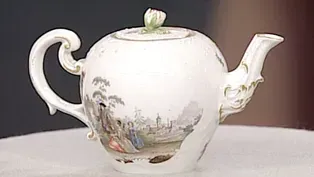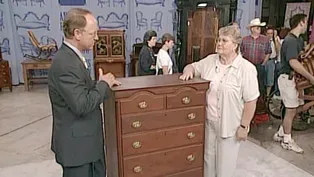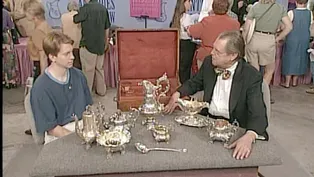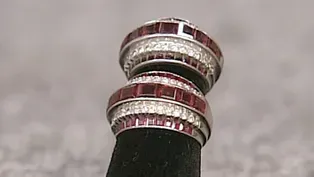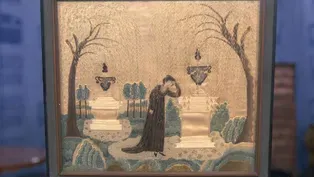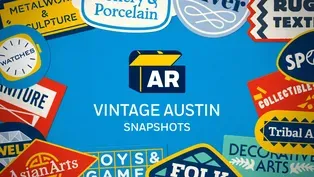

Vintage Austin
Season 21 Episode 21 | 52m 28sVideo has Closed Captions
See memorable finds appraised 17 years ago!
See memorable finds appraised at ROADSHOW 17 years ago. Highlights include an H. Siddons Mowbray painting, an 1802 Meriwether Lewis commission, and Marilyn Monroe photos from 1953. Learn which item’s updated appraisal has $165,000 added to the value.
Problems with Closed Captions? Closed Captioning Feedback
Problems with Closed Captions? Closed Captioning Feedback
Funding for ANTIQUES ROADSHOW is provided by Ancestry and American Cruise Lines. Additional funding is provided by public television viewers.

Vintage Austin
Season 21 Episode 21 | 52m 28sVideo has Closed Captions
See memorable finds appraised at ROADSHOW 17 years ago. Highlights include an H. Siddons Mowbray painting, an 1802 Meriwether Lewis commission, and Marilyn Monroe photos from 1953. Learn which item’s updated appraisal has $165,000 added to the value.
Problems with Closed Captions? Closed Captioning Feedback
How to Watch Antiques Roadshow
Antiques Roadshow is available to stream on pbs.org and the free PBS App, available on iPhone, Apple TV, Android TV, Android smartphones, Amazon Fire TV, Amazon Fire Tablet, Roku, Samsung Smart TV, and Vizio.

ANTIQUES ROADSHOW 2025 Tour!
Enter now for a chance to win free tickets to ANTIQUES ROADSHOW's 2025 Tour! Plus, see which cities we're headed to!Providing Support for PBS.org
Learn Moreabout PBS online sponsorshipWe've got something here that is two years later than the Alamo.
Houston, 1838.
This is the, about, 20th guitar we've seen here today.
I mean, Austin is definitely a guitar town.
WALBERG: The antiques market is constantly changing.
The bubble burst in the Japanese art market in the late '80s and early '90s, and prices have readjusted.
The ticket market's starting to grow.
Dining room furniture today is not nearly as valuable as it was years ago.
This market has been seeing enormous jumps in it, like, just crazy.
WALBERG: Tonight in "Vintage Austin," you'll see another market that jumped like crazy.
The value of this Meriwether Lewis document has seen a big change since the 2004 Lewis and Clark bicentennial.
But first, a look at this Texas treasure.
Besides being very old and tattered, it's a book of the, from the Texas General Land Office of the original title of record.
It was printed in 1838, when Texas was a republic.
It has to be printed by the Congress of Texas because they needed a record of who are the original land holders at the time of being the republic.
And these presumably, throughout these pages, are those original land holders to whom property was granted.
Is that correct?
Yes, sir, that is correct.
It was my grandfather's, and we think he got it from his father, which owned a good bit of property in east Texas, but he could have also gotten it through my great maternal grandmother, who was also related by marriage to the Houston family.
We're not sure, but we got it now.
Yes.
Items of this type come up for market extremely rarely.
And we've got something here that is two years later than the Alamo.
Houston, 1838.
The physical condition, as you've said, does leave something to be desired, but conservation could soon put this right.
My mother was doing a lot of research, and I guess originally, there was about 1,000 printed.
Yes.
But she thinks she can only find about 12 in existence.
12, yes.
Yes, sir.
And most of them are really, are only in public institutions.
I believe in 1966 or 1967, one was valued at about $2,500.
Wow.
And I think now that you could certainly put a comfortable auction estimate of $20,000 to $30,000 on it.
And it might be worth significantly more, because the auction estimates now are fairly conservative.
And I hope you're...
I hope you're happy with that.
I'm just shocked.
All right, well...
I'm speechless.
Tim, your grandfather was a really interesting artist, but this is just such a luscious painting.
Henry Siddons Mowbray was born in, actually, Alexandria, Egypt, in 1858, studied in Paris, and died in 1928.
You have an idea of when this was painted, and what series it's from, don't you?
I think it was painted at around 1895.
I don't know the exact date of this, but other paintings similar to it were painted at that time.
Well, apparently, your grandmother wrote that your grandfather was very much influenced by classical themes, with themes of the American Renaissance, and with figures of muses and virtues, and these lovely allegorical figures are terrific.
You were telling me that you would wake up to this painting in your bedroom when you were 16 years old.
Yeah, he considered his murals much more important than his easel paintings like this, but I was much more enamored by these paintings than the murals.
What's interesting to me-- you mentioned the murals-- is that he was great friends with Augustus Saint-Gaudens and with the architectural firm of Stanford White, McKim, Mead, and White.
And the great mansions that were being built in Newport and New York have design programs that were commissioned by these architects that your grandfather worked on.
Because it was the American Renaissance period, they were building Renaissance-style architecture and interiors that went along with it.
So a lot of Roman scenes, a lot of classical scenes.
And, again, these absolutely beautiful figures.
A beautiful palette.
We have the roses, the pastel colors of the figures, a great aesthetic accomplishment in the easel format.
It's just a terrific example of the painting and of the period.
Given that, at auction, I would estimate it at between $50,000 and $75,000.
Wow.
I could never sell it, unfortunately.
It would stay in the family.
Nice to wake up to.
(both laugh) Thanks for coming.
Well, thank you.
You know, it's not surprising that this is the, about, 20th guitar we've seen here today.
I mean, yeah, Austin is definitely a guitar town.
The value on this about $400, thereabouts.
WOMAN: This plate is actually a piece of presidential china from Ulysses S. Grant.
He married my great-great-aunt Julia Dent.
A superb example of presidential china.
APPRAISER: This is sort of the premier example of what a great cocktail shaker should look like.
I think you might have overpaid at $2.
(inaudible) (both laugh) We sell them for about $3,000 to $5,000.
No!
Uh-huh.
I didn't know that.
Robots were huge in the 1950s and the 1960s.
I would say that this one's probably '58 to around '62 or '63, maybe a little bit later, because of the, because of the plastic in the back.
They would have used just tin in earlier robots, for the most part.
So he's probably into the '60s sometime.
But you told me a story, you said that you couldn't get him to work.
MAN: Yeah, when I first got him, the part up here was hanging down on its side, and I knew it went in here.
Right.
But I was looking for a switch, and I could never figure out where the switch was.
And one day I just pushed him down, and he took off running.
That's great!
My grandfather was from Galveston and went to college in Connecticut, met and married my grandmother, whose family still had the royal charter on her home.
When she returned to Texas, she brought ancestors with her.
Her great-great-great-aunt and uncle.
His name was Frederick Seymour and his wife was Prudence Miner.
Her picture was done in 1799, his was done three years earlier, and they've descended in the family ever since.
And where did they live, Peter?
He was a sea captain and merchant in Hartford, Connecticut.
She was from New London, Connecticut.
And you know a little bit about the artist.
And can you tell us?
Well, I'd not known anything until an article in the magazine Antiques, a wonderful article on a woman name of Mary Way, from New London.
And I wrote a letter to the author of the article.
He felt it was an easy attribution to Miss Way.
That's about as far as I can go with it.
Well, this is an example of wonderful things coming in a small package.
Mary Way was a very versatile American artist, specializing in portrait miniatures.
And what is so marvelous about her work is, she's the only American miniaturist that we know of that worked in a three-dimensional manner called dressed miniatures.
She managed to create a three-dimensional effect by painting in watercolor and then actually picking out the clothing with scraps of fabric that she would cut and fold and then touch up with paint on top of that.
Neither of these are in their original frames, I should point out, but the detail and the wonderfulness of Mary's technique certainly shines.
In her portrait, we have this incredible ability to pick out detail: the hat, its many layers, its see-through quality.
And down on the arm, her dress actually has sleeves of a very light gauze material, and you can just make out little details of flowers which are embroidered into that gauzing.
This is an incredibly difficult thing to do effectively.
She certainly deserves her newfound fame as one of the great women artists, as well as American miniaturists of the late 18th, early 19th century.
She was born in 1769 in New London and died there in the early 19th century.
Well, they are superlative examples, and I would conservatively estimate that these would be in the $20,000 to $30,000 range.
Yikes.
Nice to know.
Heavens!
Yes, I had no idea.
Well, you've started off well by having them properly, professionally conserved, and I know you'll treasure them.
I certainly will.
Thank you so very much.
WOMAN: My grandfather was from Temple, Texas, and these were his salesman samples.
He would go out in the community or to other little towns and villages and show the people what he had for sale.
And I played with these salesman samples all my life.
Well, I collect salesman samples myself, and technically, we don't call this type of stove a salesman sample.
Oh, you don't?
It's almost more of a child size because it is named the Buck's Junior #4.
So, but I think they used these to display what the real big things were like.
They didn't have quite the detail of a normal salesman sample.
It has nice detail, though.
It has nice nickel plating, opening doors, and it's really quite a fine piece.
It has a couple of condition problems.
I know.
You're missing these little hinges and a little plate.
But believe it or not, these can be replaced.
Oh, I'm glad to know that.
This I really consider a salesman sample.
And this, I've never seen one quite like this.
Really?
The reason we call it a salesman sample is because it has in absolute miniature the real features of the item that was being sold.
Here we have the compartment where the ice was installed.
Here we have the shelves.
And... Did you ever notice this here?
I never noticed that.
Well, this is the drain.
No, I see that now, but I have never had it... To drain off the ice water.
I know!
I should have known that.
Well, you have two gems here.
The stove, even though I don't consider it a salesman sample, is worth about $2,500, even in this condition, missing a piece.
Gosh, I'm going to get this piece, then.
Well, that's easily done.
But now this is another kettle of fish.
Really?
Yes.
If I owned this piece, I wouldn't sell it for a penny less than $5,000.
I am stunned-- I'm stunned.
And I've just been letting our grandchildren-- we have seven grandchildren-- I've been letting them play with it.
If they play with it carefully, that's okay.
But they better be real careful with this one.
All right.
My great-grandfather owned a pawn shop down on what's now West Sixth Street, then known as Pecan Street.
And Ben Thompson, a notorious gunman from the Austin area, grew up here.
Also had problems with finances, apparently.
So quite a bit of his material ended up in my great-grandfather's pawnshop at the time he was killed in San Antonio.
So you're a fifth-generation Austinite, and your family was in business in...
It was a smaller city then.
And colorful Ben Thompson owned this hall stand.
And we know that it's true because it's signed on the back by your great-grandfather, and we can confirm the story because there's lots of literature on Ben Thompson and his possessions being bought by your great-grandfather.
Isn't it remarkable to think of Ben Thompson himself adjusting his gun holsters in front of this mirror, picking up his cap and going out, doing the rounds of Austin?
That is if his gun and holster weren't in the pawn shop, as well.
Well, it was a thrill to see this, because it's a, of course, a very interesting Victorian hall stand from the 1880s.
Then you began to tell me the history a little bit, about Ben Thompson.
He considered Austin his city.
You showed me some of the newspaper articles here.
When he wasn't in trouble with the law, he was actually running for marshal.
He didn't get elected, and the local newspaper says, "Just to prove there were no hard feelings, "Ben took to a little celebrating "and shot up a saloon, "half a dozen sporting houses, and the daily newspaper offices," left town for a couple of years, and then he was elected marshal.
That's correct, he came back and was elected.
So I guess the saying is, "If you can't lick 'em, join 'em."
What a wonderful piece of history to see an original, colorful member of the community come here and one of his pieces of furniture survive all of this time-- it's really remarkable.
Most Victorian hall stands like this might be $1,000, $1,200, but with this fantastic history of being owned by one of Austin's local, colorful figures from the 1880s, it adds a big premium, and I think it's $3,000 to $5,000, just for the history alone.
All right, thank you very much.
APPRAISER: Beautiful modeling.
They're almost really more in the French style, as opposed to the Italian style.
But they're terrific quality, and you have six of them?
Yes, I do.
They're probably around $4,000 to $6,000 for the set.
Wow, wonderful!
Victorian in feeling.
And I would put a value somewhere, I'd say between $300 and $400 for the pair.
Okay.
I have never seen tissue stereoviews of Sarah Bernhardt.
And these are in great condition.
And you've got a few more.
They're probably worth about $100 to $150 apiece, maybe $200 a piece.
I went to Newcomb College in the early '70s, and we had family friends who lived in New Orleans who would invite me to dinner a couple of times a month, you know, to make me feel at home.
And she loved to do estate sales.
So one time when I went, she gave me these and she said, "Well, I saw these at an estate sale and I just thought of you when I saw them," because it was from Newcomb, and so that's how I got them.
She was more generous than either of you might have thought.
First of all, the box is pretty cool.
I've only seen this three times in 30 years.
This is typical of their handicraft work.
Most people know Newcomb from their pottery, but they also did paintings, book binding, textile work, and they did wrought metal.
And what you have here is a set of six nut picks.
These are roosters, and these are sterling silver.
Now, these are made, I'm told by a good friend of mine, from, like, spoons that they would bang out and then form into different things.
They didn't just get raw silver.
They actually used implements that were, that had other uses previously.
These were made probably in the '20s, and mostly different artists did metal than did the pottery, although Henrietta Bailey did both pottery and metal.
But in 30 years, I've seen three examples of Newcomb College's silver work.
It's never marked, that's why this box is critical.
And believe it or not, these are worth about $800 apiece.
You're kidding.
About $5,000 worth of silver.
Oh, my goodness!
So congratulations, very rare and a very cool thing to see.
That is wonderful-- thank you so much, David.
It was passed down from my great-grandfather, made in Paris with old American silver dollars and then brought back here when they moved back here later on.
Yeah, that's one of the things I really find fascinating about this.
It is made out of melted American, U.S. silver dollars, and your...
The grandfather was a... great-grandfather was a Confederate sympathizer?
Right.
And he fled the country with his money and had the tea set made in Paris.
Right, exactly.
And he was looking for support from Napoleon III, as I understand it.
Yes, sir.
Well, the set, as you know, comes in this beautiful, fitted antique box, 19th-century, original box, all fitted for the sterling set.
And this set was made by a company by the name of Odiot, that's O-D-I-O-T.
They are the most famous silversmiths in France.
The quality of the set is absolutely superb.
The detail, the workmanship, everything about this set.
Look at Neptune on the top of the pitcher.
It's just beautiful, beautiful quality sterling, by your very finest maker, a huge set, obviously.
Well, I think that in a well-advertised auction, an antique tea set like this from France, mid-19th century, this kind of history, you're talking somewhere in the area of $70,000 to $90,000.
Wow.
Wow, that's incredible.
Thank you very much for bringing it to the Roadshow.
My pleasure.
I thoroughly enjoyed it.
My pleasure.
Nowadays, it's all about who wants to marry a multi-millionaire.
But back in 1953, it was merely How to Marry a Millionaire.
And these photos you brought us take us right to the premiere with Lauren Bacall and Marilyn Monroe.
Who took them?
My father photographed these.
He was a student in California and had a bet with a friend that he could get a picture of Marilyn Monroe, and he won.
So he snuck in?
Actually, he had a friend who got him a ticket, but it wasn't a press pass.
It was a regular ticket to get in.
But he took his camera.
He made a number of photographs.
In fact, in some of them, you can actually see the press photographers in the background.
That's right, I see them.
That's amazing.
In an interesting turn of events, he was able to get in and get these photographs.
Well, setting the scene a little bit, in 1953, Marilyn Monroe made herself into a box office star.
She had a long ascendancy.
It wasn't until Niagara with Joseph Cotten that she actually became a breakout star, but in 1953, she had two top ten box office hits, Gentlemen Prefer Blondes with Jane Russell and then, of course, How to Marry a Millionaire with Lauren Bacall and Betty Grable.
And she kind of perfected light comedy and what they now call a dumb blonde role.
But in many ways this was the zenith of her career.
She was just about to marry Joe DiMaggio, and it was a wonderful time for her, as you can see from these fabulous photos.
They're professional looking quality.
Well, he was a student learning to be a professional photographer.
Well, he's done a good job.
Now, let me ask you, have you ever had these appraised?
I did send them off to two houses and got a card back from one saying, "We'll get back to you," never heard from them.
Okay.
And got a letter back from Sotheby's just on the photographs themselves, but not on the negatives, and that's what we keep asking about because I have the original negatives for the ten photographs that he took.
And that's very unusual.
We're going to look at a couple of different things here.
All together your dad took ten photographs.
So we look at one, obviously, who's in the photographs and the fact that you say they've never been published.
Correct.
And if that's true, and the quality of them, that makes them more valuable than a lot of sort of home movie type photos that get taken.
The negatives are also very valuable, because you're looking at whether you sell them with the copyright or without the copyright.
And the third thing that you're looking at is the fact of timing.
For instance, if you go back to the mid-'80s, Marilyn was very hot when Madonna made her video, kind of playing off of Marilyn's "Diamonds are a Girl's Best Friend."
Then, of course, there was a blockbuster sale of her estate last fall.
My feeling is that if you sell these without the copyright, the ten photos themselves, very conservatively, I would put them at $6,000 to $8,000 for the grouping.
Now, if you're selling them with the copyright and someone gets an exclusive and wants them for an archives, you just don't know what they could do.
I'm not a copyright lawyer.
I've never had to deal with it, but they could be much, much more.
It really depends at the timing and what the open market will bring.
Right.
But they're fantastic photos.
Your dad did a wonderful job in shooting them.
Well, I know very little about them.
I found them in a garage sale in Seattle.
Wow.
About two years ago.
And I assume they are a child's headdress.
They are, and they're from mainland China, and they were probably made in the 1920s, 1930s.
Okay.
And these brilliant-colored dyes were aniline dyes that were introduced from Europe in the 1890s, and spread basically all over China within a matter of ten or 15 years because the Chinese loved these brilliant colors here.
Right.
But they're both done as tigers, and tigers are there as spirits to ward off evil.
Okay.
And they're also done as women's hats, but they're intentionally for young boys.
They used to dress up young boys as women.
Oh!
In order to prevent evil spirits from taking them.
Wow.
That's why the flowers and the feathers.
And if you notice on this one on the side, there are centipedes on the side, and they're, like, one of the five evils.
So they're there to protect the kid from scorpion and centipede bites.
Okay.
They're rather bizarre and attractive with the big, bulging eyes with the gold brocade, and all the little metal appliqués.
But quite a handsome piece of work.
A lot of work.
Exactly.
And the kid probably outgrew them really quick, too, had to have them made again and again.
(laughing) And did you have any idea what they were worth?
No, I don't.
I paid $15 for the pair.
$15 for the pair.
Well, they're not worth a whole lot of money, but they're still worth about $200, $250 apiece.
Oh, that's good.
And Chinese textiles like this are growing even more collectible.
I love those bulging eyes on them, staring down evil.
WOMAN: I bought this as a gift for my husband.
He was born on George Washington's birthday, which is February 22.
I won't say what year.
I was excited.
I went to a little antique shop in Richardson, Texas.
And I told the lady I was looking for something special for my husband for George Washington's birthday.
Yeah.
And she brought this out and said that it was a memorial, a mourning picture, and she thought that it was made sometime around 1820 or 1825, and thought that it was made as a memorial for the death of the three presidents Washington, Adams and Jefferson.
I thought it was beautiful.
Right.
And visited it every day for about six weeks until I could afford to buy it.
(laughing) This is a silk embroidered mourning picture that was made in South Hadley, Massachusetts, at the Abby Wright school.
Abby Wright was a school mistress who had a school in South Hadley, Massachusetts, for the education of young girls, where she taught reading, writing, and arithmetic, and also skill with needle and thread.
And that school operated from 1803 to 1811.
And as you can see, we have a combination of media and techniques here.
There's painting on silk.
There's stitchery on silk.
But what is the key characteristic of Abby Wright is this coiled silver thread, which adorns the three urns on top of this monument.
And the reality, I think, is that this was probably made for a family because the Abby Wright school stopped teaching school in 1811.
So that would have been too early.
But it's a remarkable thing, in the original glass, in the original frame, with that marvelous shimmer to it.
And these things are extremely popular.
How much did you pay for this silk embroidery?
I paid a week's salary, $500.
We would probably estimate this at around $15,000 to $20,000.
Oh!
How much?
$15,000 to $20,000.
$15,000 to $20,000.
Yes, you're blushing.
(laughing) That's unbelievable!
Yeah.
I'm going to faint!
I bought it in Wichita, Kansas, in the '80s, and I fell in love with it and wanted it for above the refrigerator instead of one of those useless cupboards.
WOMAN: Well, I bought it at an antique show about four, five years ago, and it was supposed to be a piece of Moser glass.
I was attracted by the salamander looking so realistic.
It's nice to meet you, and I like what you brought here today.
Do you know what these are?
Not really.
Well, you know they're bracelets because you're wearing them on your wrist, but these are kind of special.
These are American Victorian cuff bracelets.
I bought this doll approximately two years ago at an IRS property seizure auction.
I paid $60.
I bought two other dolls as well.
One of the ways that you can sometimes tell a Lenci is the zigzag stitching on the back of the neck.
And I'm really glad when I lifted up the wig that it was there because my first instinct was that she is a long-limbed Lenci lady, and really a very, very nice one.
She's in really quite lovely condition.
She's worth today between $1,500 and $2,000.
That's great.
APPRAISER: You brought a beautiful Victorian painting by Alfred de Bréanski.
It was my grandparents'.
I believe they bought it in England in the '40s and it hung in their home for about 40 years and then in the early '80s, my father got it.
Uh-huh.
And so you always knew this in the family house.
Yes, it's a treasure that they had.
Now it's yours.
Yes.
Well, do you know much about the artist?
I don't know anything about the artist.
I had assumed that he was maybe Polish or something.
Alfred de Bréanski was a great Scottish Victorian artist.
And he did almost exclusively these views of the Scottish countryside, the lochs and the hills, generally at sunset, with the cattle watering down there.
And the great thing about him is his ability to capture the light, the sunset, and you see that through here in the painting.
Since he does the same paintings almost over and over again, it's the quality of the light that you look for, and you have really one of the best ones I've seen in a long time.
Oh, good.
A couple of other things that are very typical of his work are on the back.
I wanted to show you that.
And, also, it helps to prove the authenticity of this work.
Right on the back it says, "The Head of Loch Lomond," one of the most important, famous lochs in Scotland.
And then it says Alfred de Bréanski, Sr.
This is a very typical thing of the Scottish academy.
Almost every Scottish Victorian artist puts where it is on the back.
They put "Head of Loch Lomond."
When you see a de Bréanski, you almost always know where it is.
Another thing you have is a Windsor Newton.
It's a manufacturer of canvas.
You can see the original canvas here.
They stamped it.
And the third thing is that it was sold by Harrod's, the famous department store in Knightsbridge.
Right, right.
Did they ever tell you what they paid for it?
Do you know what value might be on it?
No, we never discussed it.
They had two of the same size, and my aunt has the other painting, but I never had any idea what the value was.
These a few years ago, they weren't all that valuable.
They were $4,000 or $5,000, but they've recently skyrocketed in value.
And a painting like this right now, this quality and this size of de Bréanski, would be worth about $25,000 to $35,000 at auction.
Really?
They're really... it's a really fabulous example of his work.
Wow.
My great-great-great-aunt Emma had a porcelain collection, and it has passed down through my great-great-grandmother, my great-grandmother, my grandmother, and then to me as a birthday present.
Did they live in Europe or in another part of the States?
I believe that my great-great- great-aunt Emma was in Boston.
Any idea where she felt this came from?
No.
Did she identify it?
Well, the only identification that I've got is on the bottom it says "earliest Dresden."
I believe that she put it on there because that's what I was told.
But I don't know that for certain.
Your great-great-great-aunt Emma was almost correct in calling it the earliest Dresden.
Dresden is a city in eastern Germany which is famous for making porcelain.
Perhaps even more famous is the town next door called Meissen.
And it was in the town of Meissen that porcelain making actually began in Europe.
The Chinese, of course, invented porcelain over 1,000 years ago, but the Europeans didn't know how to make it until about 300 years ago, when a very bright individual in Meissen called Johann Böttger figured out, using rather primitive chemistry, how to make this extraordinary, translucent material that we call porcelain.
And they've been making it in Meissen ever since.
And some of the best porcelain made in Meissen was made in the first period of Meissen making, which is basically the first half of the 18th century.
Okay.
This teapot, it looks tiny to most of us, but at the time it was made, it was not that unusual for teapots to be very small, because they were made in the Chinese manner, really.
I thought it was made for a child.
No, it was made as a conventional teapot at the time, the time being probably about 1740.
The style of it is very Rococo.
All of that scrolling work that you can see rather delicately molded onto the body.
But what I like about the teapot is the painting on it.
The Meissen artists at the time, some of them who worked in the factory and some who worked outside the factory, were extremely talented and painted with a very, very fine hand indeed, making these remarkable painterly scenes.
The painting could be by one of the best known painters at Meissen at the time, whose name was Johann Herold.
It would really take a little more research to decide on that.
You can identify it as being early from the size, from the modeling, also from that extraordinarily well painted scene.
And the base of it, too.
We often think of Meissen as having to have a little cross swords mark, which is the very familiar mark of Meissen.
It actually is there.
You can't see it very easily, but it's very, very faint, painted on the bottom.
In any event it's a very valuable and quite important teapot because of its beautiful condition and early period.
I would have to value it today at, at least $12,000, and perhaps as much as $15,000 or even more.
Really?
Yes, really.
It's a great find and a great heirloom from your great-great- great-aunt Emma.
Thank you.
MAN: My mother got it back in the early '70s from a neighbor of hers.
She paid the lady $35.
APPRAISER: Let me tell you a few things about it.
It's a Gustav Stickley three-drawer library table, and it's a form Gustav Stickley liked a lot.
And he made it from 1901 until about 1915, so it's one of those forms that went through an evolution of design through the duration of his being in the furniture making business.
We know it's an early table for several reasons.
Number one, the marks on the inside of the drawer are fairly early marks.
They're not the earliest ones, but they date this to about 1905 or 1906, sort of in the middle of his production.
The other ways that we know it's a fairly early table is the wood selection.
There's a tremendous amount of quartered oak running all throughout the top of the table, the legs, the drawers.
Later pieces had less quartered oak.
It was expensive and rather wasteful cut of wood to make.
The piece has hammered iron, wrought iron pulls.
These are all done by hand.
Within the Arts and Crafts vernacular, handmade is best.
It's a very simple table.
There's not much going on here.
So things like the expressive grain of the wood, the wrought mark from the planishing of the metal.
These are considered decoration.
I think the other thing that is interesting about your piece is the finish is, for the most part original.
It's a little worn on the top, but with the original finish, without the termite damage, this is a $10,000 to $15,000 table.
This is fairly significant damage on the back leg of this table.
This leg would either have to be completely replaced or certainly patched in, and that's the reason why it's only worth about $5,000 to $7,500.
But all in all, one of Gustav's best library table forms.
A good middle period piece.
An heirloom, I think, for your family.
Yeah, I really like it.
I wish I could get chairs to go with it.
Well, it's not really... it's not a sitting piece.
Right.
Because of the drawers, your knees won't clear it, and, also, you'll have bruises on your shins from pulling up against the shelf.
Well, if you're short like me, it works out.
Hey, whatever works for you.
Brussels had a large flood.
There was thousands of homes that were flooded.
And in the flood, the water came up to this line right here.
The bottom started coming apart, so I had to have it archivally restored.
She used waxes and she used varnishes that were appropriate.
And she took her time.
Well, here's an example of what I think was a very good restoration job.
They matched the colors.
The old surface is still there on the door.
The thing that you should know about English clock making is that many clocks were remade, sometimes one or two times, throughout their lives.
Originally, this was an 18th century clock that was made by a man who signs it on the dial and that's how most grandfather clocks are marked.
This one is Carter, and he worked in a town, Ampthill.
Judging from the dial of this clock, this looks like the kind of thing they were doing in the late 1700s.
But it's very unusual because it has what we call three trains.
Three trains means that not only does it strike, but it also chimes, or strikes the quarter hour.
Originally, this had a case where it was a square dial.
I see.
And then somebody added this baroque arch, when they made this case.
I see.
Many of the cases were oak cases.
They were rather plain.
They were country in style.
They were solid oak, but then they were taken, and in the late 1800s, recarved.
So if we can imagine this as a flat surface, it now has been carved to accept this very Gothic style, which it now has.
There was a Gothic revival at that time.
The clockworks, however, has all the traits of a classic English clock.
I'm going to take this off.
Okay.
And we have to unlock it.
This has the lock still intact.
And hold on there.
Because we don't want this to fall down.
I always put my thumb there on that door so it won't...
Okay, open up.
...come crashing into your face.
If we look at the inside of this, you notice that down here there are four bells, and they were designed to strike the quarter hours.
(bells chiming) Very much like a Westminster chime.
It's a quarter-hour chime.
Okay.
So my conclusion about this clock is that, although there are alterations, I believe that the clockworks itself were originally made by Carter, and it was originally made 1700s, in Ampthill, but then it took later modifications and remaking to come to the point where we are now with this case.
I'm going to put the top back on.
I think you can call this an antique, although it's different in nature.
I wouldn't be surprised if in today's market, you'd find a clock like this selling in the range of $8,000, $10,000.
Wow.
I see.
So that's...
Better than the $300 he paid for it.
These plates were actually made by the Wedgwood China company in England, and they made plates for universities all over the United States in the 1930s through the 1950s, which you could buy generally in the bookstore, through the alumni association.
And each plate has a different scene of somewhere on the campus.
In fact, this plate right here that I've got is the old main building.
Also, another interesting thing about these, on the back, it's got the first few bars of "The Eyes of Texas are Upon You," which is an interesting little addition.
This is such a nice painting by Bryant Chapin.
It's really a great example of his work.
He was a late 19th century American still life artist.
And what's different about his work compared to the mid-century artists, is that it's much cleaner and fresher.
The piece here that I like the most because I am a sort of poster nut is this one here, which is a poster about posters.
It's posters from all the different allied countries combined into one image.
And the great thing is, too, that you actually have one of the posters here that's pictured in miniature.
So this image is the same as that image there.
My father-in-law was a rancher in west Texas, and I grew up on a ranch in west Texas.
Where?
Out around Amarillo.
I see.
And through the years he collected barbed wire.
And when I joined the family back in the 1970s, I started helping him out with his collection, and he began mounting it on boards and putting it in a form like this in the '70s.
And there's nine of these boards now, 146 kinds at this point, that we know about.
Well, these are not particularly valuable as an individual item.
They're worth $10 to $20 apiece.
Of course you have nine panels of these, you said, so it sort of adds up.
The great thing is, this is an important piece of Texas history, and it needs to be preserved.
I started collecting furniture because I needed to furnish a home, and it has been the hobby of a lifetime.
I started in the '60s.
I would start with a full pocketbook and an empty van, and I usually came home when the pocketbook was empty.
Well, this is a North Carolina tall chest.
It's walnut primary wood, yellow pine secondary, and it probably dates to around 1790, 1800, 1810.
A piece like this tells the story of Germanic cabinet making traditions, because the first place that you usually see these coming from is in Chester County, Pennsylvania, and then the people that were Germanic settlers came down the great wagon road, and the next place that you see them is in the valley of Virginia.
And the place where I've seen them the most is down in North Carolina.
And the first thing that attracted me to them was the fact that they had these nice arches in the drawer tops.
And one of the things that I wanted everybody to see was the fact that on this side, you can see where the moldings repeat themselves.
Yes.
On the sides.
That attracted me to it, too.
Yeah, and the fact that it's so vertical.
It's got fluted quarter columns.
Yes, yes.
Which is a nice formal characteristic.
Yes.
And the other thing that you always look for in Southern furniture that I don't think everybody thinks about that much, is the fact that it's very overconstructed.
What do you mean by "overconstructed"?
Well, look how heavy the secondary wood is.
Oh, yes, it's like lead.
I'll say, when you have to pick this thing up, it gets real heavy.
It does.
And the other thing that tipped me off-- and I want to show everybody this real quick-- are these reinforcing pieces.
I've never seen anything like that.
They come all the way through the chest.
And it's over reinforced all the way around.
It's got great big glue blocks up under the feet, which has kept the feet from breaking off through the years.
And it creates... it gives you a nice sense of what these cabinetmakers were doing, how their own interpretation of it was.
And that's some of the things that we look for when we think about an item being from the South versus being from New England or Pennsylvania.
So you think this is a Southern piece?
Oh, absolutely.
Did you not say that the family came from North Carolina?
North Carolina, yes.
But the family also went up to New England and Pennsylvania to shop.
Without a doubt it's mid-Atlantic.
My feeling is that it's a Southern chest of drawers.
It was made in North Carolina.
Oh, my goodness.
And on a scale of one to ten, that sort of takes you into the rarity thing, because there's much less quantity of these types of chests in the South than there would be in Pennsylvania.
Why don't you tell everybody what you paid for it?
Well, I paid between $2,200 and $2,600, and this was in 1988.
1988.
Mm-hmm.
Hmm.
We talked amongst ourselves, the other appraisers at the furniture table, and as far as we're concerned, conservatively, in my opinion, this chest is worth $12,000 to $18,000.
How wonderful.
When my mother met my father, he was taking care of his widowed mother.
My mother was a little concerned, because she thought if she married my father, that she might have a clingy mother-in-law.
However, when she married my father, my grandmother took off on a world vacation and she collected things.
She liked miniature furniture.
Pianos, also, were included.
Well, they're lovely pieces.
I'd like to tell you a little bit about the furniture that you have.
The little parlor set, actually, was made in Czechoslovakia.
It's made up of a gilded metal with a little enamel insert to look like an upholstered back.
The enamel is decorated with transfer printing.
It was a little bit more economical than hand-painting.
The little parlor set would probably sell in the value of about $50 to $100.
On the other hand, you have another piece with the parlor set, is the little piano.
This is silver with an enamel overlay.
It's made in Austria.
It's what is referred to as a Vienna enamel.
It's hand-painted.
Very nice detail.
This would have been made probably about 1920.
The little keyboard opens up and you can see the little hand-painted keys, made the first quarter of this century.
If I turn it over slightly, you can actually see where it is stamped Austria.
Right.
These are very collectible.
The work on it is all done by hand, very carefully painted on the top and on the lid here.
This piece would probably sell in the neighborhood of about $1,500 to $2,000.
Oh, my.
Your parlor set is in very good company with the little Viennese Austrian piano.
How interesting-- funny, I had always thought it was a complete set, but I guess it's... obviously it's not.
Most presidential documents are valuable because of who signed them, but the document that you brought in is really significant because of who it was given to.
Who was that?
Meriwether Lewis.
And how did you happen to come across the document?
Well, my family's descended from Meriwether Lewis' sister, and he, of course, had no offspring of his own.
My great-grandmother grew up in the Lewis family home in Locust Hill, Virginia, and one day, as a young girl, she found the commission as she was rummaging through an old chest.
And she was told that she could have it.
Years later, as a grown woman, she and her husband and children were living in Galveston Island in 1900, when the horrible hurricane struck that city.
Their home was completely destroyed, but they managed to salvage just a few of their treasured possessions, their silver and apparently this document.
And this document.
You referred to it as a commission, which is what it is.
It's Thomas Jefferson, appointed Meriwether Lewis a captain in 1802, and that was two years before...
The Lewis and Clark expedition.
And that's really what makes this so intriguing.
It could almost be seen as the genesis of the Lewis and Clark expedition, which, from 1804 to 1806, went from St. Louis to the Pacific and back.
Congress authorized the expedition in order to open up trade ties with the Indians, but in fact, it really proved the feasibility of transcontinental travel, and probably remains the most important expedition in American history.
In addition to Jefferson's signature, it was counter-signed by the secretary of war, but as I say, both of those pale in significance to Meriwether Lewis.
What a magical name in American history.
Um...
If this were a typical Thomas Jefferson military commission, I would value it at about $4,000 to $6,000.
What do you think the increase in value might be for its having been given to a significant historical figure?
Two separate individuals have looked at it.
One said around $4,000 to $6,000, another said about $75,000.
Well, it's funny, I'm going to come down about halfway between.
I would estimate this at auction between $25,000 and $35,000.
If it wasn't faded the way it is, I might go a little bit stronger, but believe me, it's the sort of thing that would cause excitement, and the final price could well exceed that estimate.
This was my great-aunt Helen's, and she traveled to Europe a lot.
She supposedly got it on one of her trips about 30 years ago, and that's all I know about it.
Okay, well, that's good enough.
Now, you can see that it is a plate.
Yes.
Not a plate that you would consider eating off of.
This is for looking, not eating.
Right.
It is a, what we call a cabinet plate, and it's made in Vienna, actually, around about the turn of the century.
And you can actually tell because the border-- you see this wonderful Art Nouveau border?
And actually, the depiction is a woman called Les Bacchantes, which is a woman who worships Dionysus.
Basically, a party girl.
Grapes in her hair and whatnot.
And actually, one of the more significant things about this is that it's signed here in the corner by a man named Wagner, or Vahg-ner.
Now, a lot of pieces from this time period are signed by this man, and in truth, if he had painted everything that he signed, he would probably still be painting.
But actually, this really is done on a design by him.
Oh, okay.
Beautifully framed.
Because it's in this shadowbox, the gold has remained nice and beautiful.
The painting, the hand-painting on this is fantastic.
Typically, you get the hand-painted examples and then ones that are done by transfer print, or like a decal.
Well, this is much, much better than that, and actually, we're going to go on a little journey of discovery here.
Now, this is a modern framing, so we're not going to hurt anything by doing this.
Now, I haven't done this, so I'm pretty sure what I'm going to find.
So I'm just going to poke my finger through here and pull this down like this.
Don't worry, easy to replace.
Okay.
And actually, so what we have on the back here is actually the name of the figure here.
That's the title, which is Hebe.
Oh.
And then we have this here, which people in the United States call a beehive mark, which in reality is the crest off of the Habsburg family armorial.
So actually, and this means from the factory in Vienna, Austria.
And so they call this a beehive mark.
This is probably another factory mark, and painter's mark down here.
So that's exactly what we expected to find.
Maker's mark, title, and the painter's mark.
Now, going back to the pretty side, these come up, they're actually fairly common.
But this example happens to be a particularly good one.
One in this condition, framed nicely, beautiful quality, signed Wagner, worth probably around $1,500 to $2,000.
Wow.
Very nice.
Great!
Very nice.
WALBERG: I'm Mark Walberg, thanks for watching.
See you next time on Antiques Roadshow.
Appraisal: 1796 & 1799 Mary Way Dressed Miniatures
Video has Closed Captions
Clip: S21 Ep21 | 3m 14s | Appraisal: 1796 & 1799 Mary Way Dressed Miniatures, from Vintage Austin. (3m 14s)
Appraisal: 1802 Meriwether Lewis Officer Commission
Video has Closed Captions
Clip: S21 Ep21 | 2m 45s | Appraisal: 1802 Meriwether Lewis Commission, from Vintage Austin. (2m 45s)
Appraisal: 1838 Texas Land Office Book
Video has Closed Captions
Clip: S21 Ep21 | 2m 15s | Appraisal: 1838 Texas Land Office Book, from Vintage Austin. (2m 15s)
Appraisal: 1916 Rookwood Scenic Vellum Plaque
Video has Closed Captions
Clip: S21 Ep21 | 1m 3s | Appraisal: 1916 Rookwood Scenic Vellum Plaque, from Vintage Austin. (1m 3s)
Appraisal: 1953 Marilyn Monroe Photos
Video has Closed Captions
Clip: S21 Ep21 | 3m 8s | Appraisal: 1953 Marilyn Monroe Photos, from Vintage Austin. (3m 8s)
Appraisal: 1994 English Tall Case Clock
Video has Closed Captions
Clip: S21 Ep21 | 3m 15s | Appraisal: 1994 English Tall Case Clock, from Vintage Austin. (3m 15s)
Appraisal: Alfred de Bréanski Sr. Painting, ca. 1900
Video has Closed Captions
Clip: S21 Ep21 | 2m 17s | Appraisal: Alfred de Bréanski Sr. Painting, ca. 1900, from Vintage Austin. (2m 17s)
Appraisal: Austrian Piano & Czech Miniatures
Video has Closed Captions
Clip: S21 Ep21 | 1m 56s | Appraisal: Austrian Piano & Czech Miniatures , from Vintage Austin. (1m 56s)
Appraisal: Barbed Wire Collection, ca. 1880
Video has Closed Captions
Clip: S21 Ep21 | 58s | Appraisal: Barbed Wire Collection, ca. 1880, from Vintage Austin. (58s)
Appraisal: Ben Thompson's Hall Stand, ca. 1879
Video has Closed Captions
Clip: S21 Ep21 | 2m 24s | Appraisal: Ben Thompson's Hall Stand, ca. 1879, from Vintage Austin. (2m 24s)
Appraisal: Chinese Headdresses, ca. 1925
Video has Closed Captions
Clip: S21 Ep21 | 2m 1s | Appraisal: Chinese Headdresses, ca. 1925, from Vintage Austin. (2m 1s)
Appraisal: Display Stove & Salesman's Sample Ice Box
Video has Closed Captions
Clip: S21 Ep21 | 2m 30s | Appraisal: Display Stove & Salesman's Sample Ice Box , from Vintage Austin. (2m 30s)
Appraisal: Gustav Stickley Library Table, ca. 1902
Video has Closed Captions
Clip: S21 Ep21 | 2m 13s | Appraisal: Gustav Stickley Library Table, ca. 1902, from Vintage Austin. (2m 13s)
Appraisal: Henry Siddons Mowbray Painting, ca. 1895
Video has Closed Captions
Clip: S21 Ep21 | 2m 21s | Appraisal: Henry Siddons Mowbray Painting, ca. 1895, in Vintage Austin. (2m 21s)
Video has Closed Captions
Clip: S21 Ep21 | 33s | Appraisal: Kuba Rug, ca. 1877, from Vintage Austin. (33s)
Appraisal: Long-Limbed Lenci Doll, ca. 1925
Video has Closed Captions
Clip: S21 Ep21 | 39s | Appraisal: Longed-Limbed Lenci Doll, ca. 1925, from Vintage Austin. (39s)
Appraisal: Meissen Teapot, ca. 1740
Video has Closed Captions
Clip: S21 Ep21 | 3m 21s | Appraisal: Meissen Teapot, ca. 1740, from Vintage Austin. (3m 21s)
Appraisal: Newcomb Nut Picks, ca. 1925
Video has Closed Captions
Clip: S21 Ep21 | 1m 28s | Appraisal: Newcomb Nut Picks, ca. 1925, from Vintage Austin. (1m 28s)
Appraisal: North Carolina Tall Chest, ca. 1800
Video has Closed Captions
Clip: S21 Ep21 | 3m 18s | Appraisal: North Carolina Tall Chest, ca. 1800, from Vintage Austin. (3m 18s)
Appraisal: Odiot Sterling Silver Tea Set, ca. 1851
Video has Closed Captions
Clip: S21 Ep21 | 1m 53s | Appraisal: Odiot Sterling Silver Tea Set, ca. 1851, from Vintage Austin. (1m 53s)
Appraisal: Platinum, Diamond & Ruby Rings, ca. 1935
Video has Closed Captions
Clip: S21 Ep21 | 1m 3s | Appraisal: Platinum, Diamond & Ruby Rings, ca. 1935, from Vintage Austin. (1m 3s)
Appraisal: Silk-embroidery Mourning Picture, ca. 1810
Video has Closed Captions
Clip: S21 Ep21 | 2m 35s | Appraisal: Silk-embroidery Mourning Picture, ca. 1810, from Vintage Austin. (2m 35s)
Appraisal: Vienna Cabinet Plate, ca. 1897
Video has Closed Captions
Clip: S21 Ep21 | 2m 53s | Appraisal: Vienna Cabinet Plate, ca. 1897, from Vintage Austin. (2m 53s)
Providing Support for PBS.org
Learn Moreabout PBS online sponsorshipSupport for PBS provided by:
Funding for ANTIQUES ROADSHOW is provided by Ancestry and American Cruise Lines. Additional funding is provided by public television viewers.



